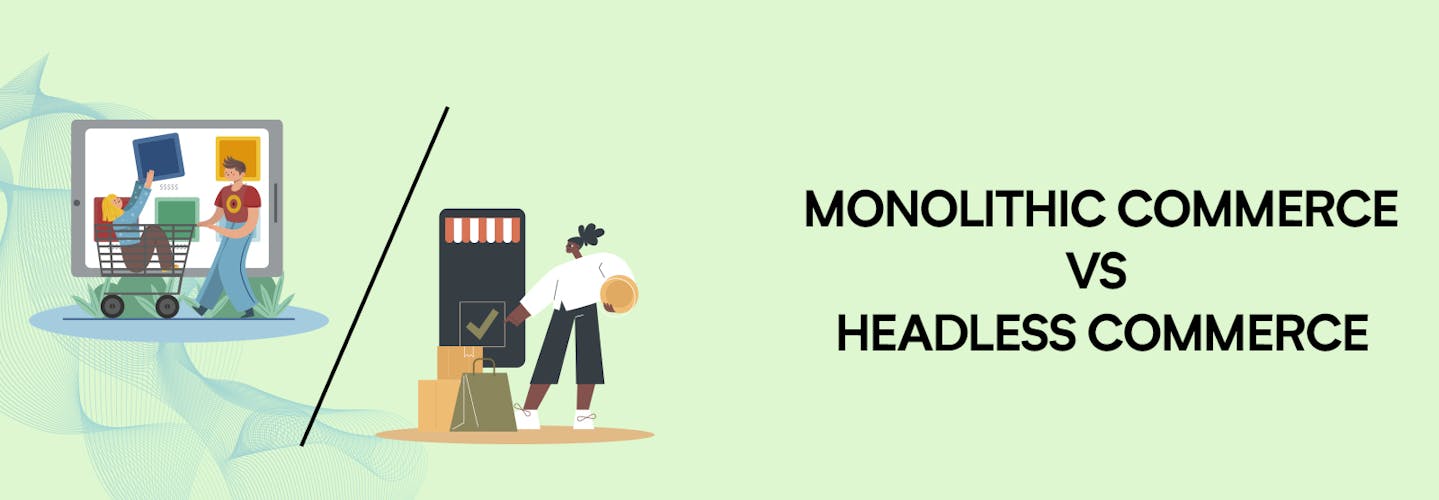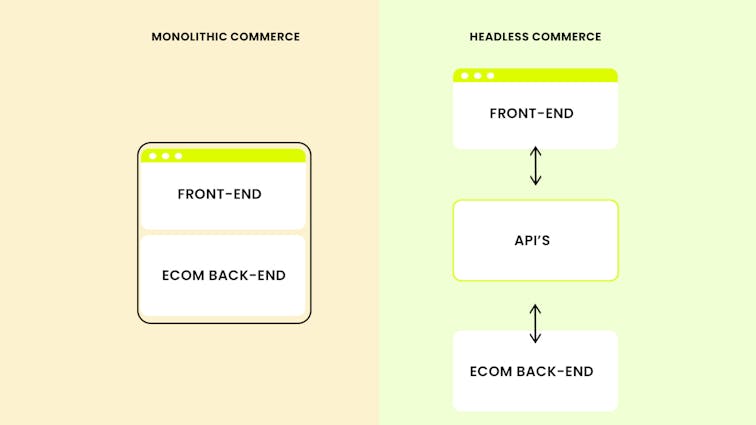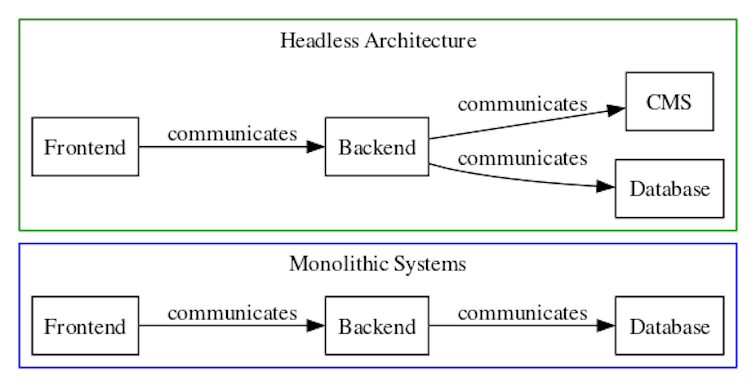
Monolithic Commerce vs Headless Commerce: What You Need to Know
Hello there, dear reader!
Have you ever wondered how the digital world of commerce operates? Well, you’re in for a treat today!
We’re about to embark on a journey through the fascinating landscape of digital commerce.
Along the way, we’ll get acquainted with two key players in this realm: monolithic and headless commerce.
So, fasten your seatbelts, because this is going to be an enlightening ride!
Brief Overview of the Digital Commerce Landscape
Let’s start with the basics. Digital commerce, or e-commerce as it’s often called, is like a bustling marketplace, but online.
Imagine walking through a market with stalls as far as the eye can see, except it’s all happening on your screen.
According to some sources, global e-commerce sales are expected to reach a total of $6.3 trillion worldwide in the year 2025.
That’s a 10.4% of annual increase between the forecasted period of 2021 and 2026. The global e-commerce market share is also expected to rise from 20.8% in 2023 to 24% by 2026.
Yes, you read that right, trillion with a ‘T’.
This digital revolution has changed the way we shop, and it’s not slowing down anytime soon.
But how do these online stores function? That’s where monolithic and headless commerce come into play.
Introduction to Monolithic and Headless Commerce
Think of monolithic and headless commerce as the building blocks of an online store.
They’re like the architects and engineers that make sure your shopping experience is seamless.
Monolithic commerce is like a one-stop-shop, where everything is under one roof.
Headless commerce, on the other hand, is more like a modular approach, where different parts can be assembled in various ways.
Intrigued? Let’s dive deeper into monolithic commerce.
What is Monolithic Commerce ?

Monolithic commerce, what a term, right?
It sounds like something out of a sci-fi movie, but it’s actually quite simple.
Imagine a traditional brick-and-mortar store. In a monolithic commerce system, all the components - the storefront, the inventory, the cash register - are bundled together in a single, unified platform.
It’s like having a store where everything is interconnected and dependent on each other.
The Architecture of Monolithic Commerce Systems
Picture a big, sturdy building. That’s what the architecture of monolithic commerce systems resembles.
All the elements - front-end, back-end, database - are housed in a single codebase. This means that if you need to change one thing, you might have to tinker with everything else too.
It’s like trying to remove a brick from the bottom of a Jenga tower without toppling the whole thing over.
Pros and Cons of Monolithic architecture
Pros:
- Simplicity: Everything is in one place, making it easier to manage.
- Consistency: Since all the components are tightly integrated, the user experience is often more consistent.
- Lower setup cost: Setting up a monolithic e-commerce platform can be less costly initially, as you only have to pick and integrate a single platform.
Cons:
- Scalability: It can be hard to scale, especially for large businesses.
- Flexibility: Making changes can be like turning a big ship slow and cumbersome.
Use Cases and Examples of Monolithic Commerce
Monolithic commerce is great for small to medium-sized businesses.
For example, a local boutique might use a monolithic platform like Shopify or BigCommerce.
These platforms offer an all-in-one solution that’s perfect for businesses that don’t have a large team or the resources to manage a more complex system.
Related: Headless Commerce vs Traditional Commerce: Which One Is Better for Your Business?
What is Headless Commerce ?

Now that we’ve got a handle on monolithic architecture, let’s turn our attention to its more flexible cousin - headless commerce.
If monolithic commerce is a big block of stone, headless commerce is like a Lego set. You can pull it apart and put it back together in whatever way suits you best.
In headless architecture, the front-end (the part your customers see) is “decoupled” from the back-end (where all the data is stored).
This means you can change one without affecting the other. It’s like having a display window that you can redesign whenever you like, without having to rearrange your storage room.
The Architecture of Headless Commerce Systems
In a headless commerce system, the front-end and back-end are separate entities. They communicate with each other through APIs (Application Programming Interfaces).
This is like having a translator who can speak both ‘customer’ and ‘data’. This separation gives businesses the freedom to customize their customer-facing side without worrying about the back-end.
Pros and Cons of Headless architecture
Pros:
- Flexibility: You can change the front-end without affecting the back-end, and vice versa.
- Scalability: It’s easier to scale your business. You can add more ‘Lego blocks’ as you grow.
- Speed: Changes can be made quickly, without having to overhaul the entire system.
Cons:
- Complexity: It can be more complex to set up and manage than a monolithic system.
- Cost: The increased flexibility can come with higher development and maintenance costs.
Use Cases and Examples of Headless Commerce
Headless commerce is a great fit for larger businesses or those with unique needs.
For example, a multinational corporation might use a headless commerce platform like Aasaan, Commercetools or Magento.
These platforms allow for a high degree of customization and can handle large volumes of traffic and transactions.
Monolithic Commerce vs Headless Commerce

Now that we’ve explored both monolithic and headless architecture, it’s time for the ultimate showdown. Which one is right for your business? Let’s dive in and find out!
Detailed Comparison of Both Systems
Monolithic Commerce:
- Unified System: Monolithic commerce is like a one-stop-shop. Everything is bundled together, which can make it easier to manage.
- Consistency: With all components tightly integrated, the user experience is often more consistent.
- Simplicity: It’s generally simpler to set up and use, making it a good choice for small to medium-sized businesses.
- Scalability: The downside is that it can be hard to scale. It’s like trying to move a big block of stone!
Headless Commerce:
- Flexibility: Headless commerce is like a Lego set. You can change one part without affecting the others.
- Scalability: It’s easier to scale your business. You can add more ‘blocks’ as you grow.
- Speed: Changes can be made quickly, without having to overhaul the entire system.
- Complexity: The downside is that it can be more complex to set up and manage. It’s also generally more expensive.
Factors to Consider When Choosing Between the Two
Choosing between monolithic and headless architecture isn’t a one-size-fits-all decision. It depends on your business’s specific needs. Here are some factors to consider:
- Size of Your Business: Small to medium-sized businesses may prefer the simplicity of monolithic commerce. Larger businesses may need the flexibility and scalability of headless commerce.
- Resources: Do you have the resources to manage a more complex system? If not, monolithic commerce might be the way to go.
- Future Growth: Are you planning to scale your business? If so, the flexibility of headless commerce might be worth the extra cost and complexity.
- Customization: How important is customization for your business? If you want to frequently update the look and feel of your front-end without touching the back-end, headless commerce could be a better option.
- Budget: Consider your budget for both initial setup and ongoing maintenance. Monolithic commerce may have lower upfront costs, while headless may have higher flexibility at the cost of higher development and maintenance fees.
- Technical Expertise: Do you have the technical expertise in-house or access to web developers to manage and update your e-commerce platform? Headless commerce can require more specialized skills than monolithic commerce.
Industry Trends and Shifts Towards One or the Other
The digital commerce landscape is ever-evolving. While monolithic architecture has been the go-to for many businesses, there’s a growing shift towards headless commerce.
This is driven by the need for flexibility and customization in an increasingly competitive market.
However, this doesn’t mean monolithic commerce is going away. Many businesses still value its simplicity and consistency.
The key is to choose the system that best fits your business’s needs and goals.
Making the Decision & Transition Tips for Transitioning from Monolithic to Headless Commerce

Making the final decision between monolithic and headless commerce ultimately depends on carefully evaluating your business needs, goals, and resources.
To ensure that you are moving in the right direction, constantly re-evaluate your choice to keep up with the evolving landscape of digital commerce.
If, after evaluation, you decide to transition from monolithic to headless commerce, here are some tips to help your business make a smooth change:
- Develop a clear transition plan: Outline the objectives, the scope of work, and the timeline for the transition. Involve key stakeholders in the decision-making process.
- Get expert help: Seek the assistance of professional developers and consultants experienced with both monolithic and headless commerce to guide you through the process.
- Analyze costs and resources: Make sure you budget for the necessary investments in personnel, training, and infrastructure needed for a successful transition to headless commerce. Expect the unexpected in terms of cost and time.
- Pilot with a small project: Before undertaking the entire transition, start with a small project or a new feature launch using headless commerce to learn how it works, identify any issues, and establish best practices.
- Communicate and train: It’s essential to communicate the changes and expectations to your employees, and provide them with the necessary training and support during the transition.
- Monitor and adjust: Continuously evaluate the performance of the new headless commerce platform, and make refinements as needed. It may take time to fully optimize the system, so be patient and be ready to adapt.
Remember, every business is unique, and what may work for one may not necessarily be the best choice for another.
The important thing is to give careful thought to both options and make an informed decision that aligns with your business objectives and capacity for growth.
Once your e-commerce tech stack is properly in place, it will become the foundation on which your business can thrive in today’s competitive digital world.
Stay informed, be adaptable, and keep an eye on emerging trends to continually improve your customer experience and drive growth.
Related: 11 Common Mistakes to Avoid in Headless Commerce.
The Impact of IoT and AI on Commerce Systems
As we continue our journey through the world of digital commerce, let’s take a look at two game-changers: the Internet of Things (IoT) and Artificial Intelligence (AI).
How are they shaking things up, and what does this mean for commerce systems? Let’s find out!
How IoT Devices are Changing the Demands on Commerce Systems
IoT devices are everywhere, from smart fridges to wearable tech. They’re changing the way we live, and they’re changing the way we shop.
With IoT, customers can order groceries from their fridge or buy a new outfit from their smart mirror.
This means commerce systems need to be more flexible and adaptable than ever. They need to work seamlessly across a range of devices and platforms. It’s a tall order, but it’s where the future is headed.
The Role of AI in Modern Commerce
AI is another big player in modern commerce. It’s behind the personalized recommendations you see when you shop online.
It’s powering chatbots that answer customer queries 24/7. And it’s helping businesses analyze customer behavior to make smarter decisions.
In short, AI is making commerce more personal, efficient, and data-driven.
The Advantages of Headless Commerce in an IoT and AI-Driven World
In this IoT and AI-driven world, headless commerce has a distinct advantage. Its flexible architecture means it can adapt to new technologies and platforms more easily.
It can deliver a consistent shopping experience across a range of IoT devices. And it can integrate with AI tools to deliver personalized, data-driven shopping experiences.
The Future of Digital Commerce

Predictions for the Future of Commerce Systems
As we look to the future, we can expect commerce systems to become even more flexible and integrated.
They’ll need to work seamlessly across an ever-growing range of devices and platforms.
They’ll need to leverage AI to deliver personalized, efficient shopping experiences. And they’ll need to be able to adapt quickly to new technologies and trends.
The Potential of Hybrid Systems that Combine Features of Both Monolithic and Headless Commerce
One exciting possibility is the rise of hybrid systems. These systems could combine the simplicity and consistency of monolithic commerce with the flexibility and scalability of headless commerce.
They could offer businesses the best of both worlds, making it easier to navigate the ever-evolving digital commerce landscape.
How Businesses Can Prepare for These Changes
To prepare for these changes, businesses need to stay flexible and open to new technologies.
They need to keep their customers at the heart of everything they do. And they need to choose a commerce system that can adapt and grow with them.
Related: Is Headless Commerce The Future Of Ecommerce?
Want to learn more about headless commerce?
If you’re interested in discovering more about headless commerce and exploring how Aasaan can assist your organization in leveraging your B2B business, don’t hesitate to contact us and speak with one of our commerce specialists.
Take the leap and transform your e-commerce business into a force to be reckoned with. Visit: aasaan.app now to embark on your journey of success with Aasaan.
For more insight into how aasaan can fit into your workflows, go ahead and schedule a demo!
Wrapping Up:
Choosing between monolithic and headless commerce isn’t a one-size-fits-all decision. It depends on your business’s specific needs, resources, and future plans.
Monolithic commerce might be the right choice for a small business looking for simplicity and consistency.
Headless commerce might be the way to go for a larger business needing flexibility and scalability.
But remember, whether you choose monolithic or headless architecture, the most important thing is to keep your customers at the heart of everything you do. After all, they’re the reason we’re here!
Thank you for joining us on this journey through the world of digital commerce. We hope you’ve found it informative and enlightening. Here’s to navigating the digital commerce landscape with confidence and success.
Until next time, happy selling!
FAQ’s:
What is headless vs non-headless eCommerce?
Headless eCommerce refers to a situation where the front-end (the part customers interact with) is separated from the back-end (where data is stored and managed). This separation allows for greater flexibility and customization. On the other hand, non-headless eCommerce, often referred to as traditional or monolithic eCommerce, is where the front-end and back-end are tightly coupled together, providing a consistent but less flexible system.
What is the opposite of headless commerce?
The opposite of headless commerce is monolithic or traditional commerce. In a monolithic commerce system, the front-end and back-end are closely intertwined, forming a single, unified platform. This structure offers simplicity and consistency but lacks the flexibility of a headless system.
What is headless commerce vs PWA?
Headless commerce and Progressive Web Apps (PWAs) are two different but complementary concepts. Headless commerce refers to the separation of the front-end and back-end of an eCommerce system. A PWA, on the other hand, is a type of web application that uses modern web capabilities to deliver an app-like experience to users. When used together, a headless commerce system can deliver its front-end as a PWA, providing a seamless, app-like user experience.
Why is it called headless?
The term “headless” comes from the idea of removing the “head” (the front-end) from the “body” (the back-end) of a system. In a headless system, the front-end is decoupled from the back-end, allowing each to operate independently. This gives businesses the flexibility to change or customize the front-end without affecting the back-end, and vice versa.
Who invented headless commerce?
Headless commerce was invented by Dirk Hoerig, the founder and CEO of Commercetools, in 2013.








